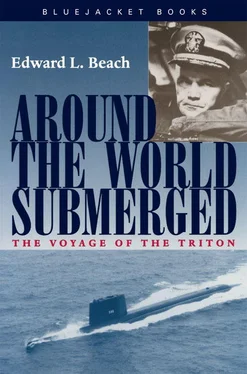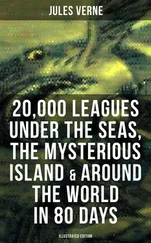Triton ’s crew had begun standing watches on our ship before she was launched; and as our personnel increased, we set up additional watches, not to make more work for ourselves, but because they were necessary. There were two officers on duty at all times, one for engineering and one for the rest of the ship. There was a “below-decks” watch whose job was to patrol the interior of the unfinished ship to guard against unexpected hazards, such as flooding, fire, gas, or failing ventilation; and we set up a crew with regular watches, under the Engineering Officer, to carry out those parts of the nuclear test program which were our immediate concern. The watches went on twenty-four hours a day, seven days a week. They are going on still—and will—until Triton is decommissioned.
2

At 4:22 A.M. on the morning of October 1, 1958, we faced our first trial. The nuclear fuel had not been loaded in the ship, but many of the steam-generating components were installed and were being tested. Steam from an Electric Boat boiler was being led into number two reactor compartment to test a stand-by condenser. Lieutenant Commander Leslie B. Kelly, prospective Engineer Officer, was on board and supervising. Engineman First Class John R. Thomas was in immediate operational control, assisted by Engineman First Class James T. Lightner. As is common with ships under construction, the compartment was haphazardly strewn with heavy timbers and other working gear.
In the corner of the compartment, Ralph Harris, Engineman Second Class, Kelly’s telephone talker, wore a telephone headset with earphones. In the center of the compartment stood one or two civilian employees of the Electric Boat testing gang. At this juncture, Thomas instructed Lightner to open one of the valves to the stand-by condenser. After he had done so, Lightner bent over to inspect the indicator at the side of the valve to see whether it was fully open, thus, by great good fortune, removing himself from the direct line of die valve stem. The very moment he did so, without any warning, stem and valve wheel shot out of the valve body and hit the steel overhead of the compartment with such force that the steel valve wheel was bent. Great vapor clouds whistled from what was now a direct opening into the steam line, and within seconds the compartment was full of scalding steam; visibility was zero.
Les Kelly immediately assumed charge of the situation. “Secure the steam!” he bellowed, his voice rising above the noise. The main valve was promptly shut, but high-pressure steam continued to spew from the hole in the line until the trapped vapor had been reduced to atmospheric pressure. Kelly quickly ordered that necessary action be taken to safeguard the plant and machinery. Then he directed the compartment to be evacuated and the watertight doors shut. The two Electric Boat workers dived out the forward hatch. Thomas, half-supporting Lightner, who had been scalded about the face and hands, came out aft. Kelly, quickly checking the compartment to see that it was clear, also proceeded aft, and was the last man out—or so he thought.
Calling a muster of all hands, checking by telephone with the forward compartment to see who had left by that exit, Kelly was dismayed to find one man not accounted for. Harris was evidently still inside the steam-filled compartment. Without hesitation, Les dived back through the watertight doorway, calling and groping for Harris in the blinding vapor. Feeling his way back to the spot where he had last seen him, Kelly discovered Harris crawling on the floor, scalded and temporarily blind, groping his way toward the exit. In a moment, the two men were back outside.
Both Harris and Lightner were hospitalized. Neither was seriously injured, fortunately, and both returned to duty within a few days. Les Kelly’s dive into the steam-filled compartment was the act of a brave man. A few more minutes of steam inhalation would have seriously injured or killed Harris, and of course Les ran the same risk. It was a pleasure to recommend him for a life-saving medal.
As a result of an investigation to discover why the valve stem blew out under pressure, a new valve was designed to make this mishap impossible in the future; all submarines with similar installations made similar changes.
In April, we experienced an accident which might have had even more serious consequences. A fire broke out in the ship’s galley from an improperly installed deep-fat fryer, and within minutes flames, sucked by fans, broke out in the ship’s ventilation lines in the immediate vicinity. Most of the Electric Boat civilian personnel rushed out immediately to notify the fire department, but one man, A. B. Evans, remained behind, aiming smothering streams of carbon-dioxide from a fire extinguisher at the base of the flame. The men from Triton ’s below-deck watch, George W. McDaniel, Sonarman First Class, and D. R. Quick, Engineman Second, swung rapidly into action. The ship’s Duty Officer, Lieutenant George A. Sawyer, Jr., had just completed his midnight inspection of the ship and had returned to our temporary headquarters on a barge moored nearby. Aroused by telephone, he mobilized all the temporarily off-watch people in the duty section and had them aboard Triton within a few minutes.
Lieutenant Tom Thamm, Engineering Duty Officer aft, ran forward to see what help he could give, calling up all the men he could spare from his test program. (It was impossible to leave this entirely untended.) Seizing fire axes, the Triton crew chopped away at the ventilation line, where the fire now was blazing furiously. Quick had stopped the ventilation fans, thus reducing the oxygen supply to the flames, and duty-section electricians cut off all electricity in the area, thus removing the basic source of the fire. Others set up temporary ventilation ducts to remove the acrid fumes and smoke from the space.
Firemen arrived within minutes, but the fire was already out. Estimated cost of the repair to the ruined galley was fifty thousand dollars. Had the fire been allowed to rage unchecked even five minutes longer, the loss might have been nearer a million dollars.
These two incidents, the faulty steam valve and the galley fire, illustrated the kind of thing that can happen to a ship going into commission. In each case, had our ship’s company not been present, the damage would have been much more severe; serious injury or even loss of life could have resulted.
But naval ships, building or already built, are not supposed to have fires. Proper checking of the deep fat fryer before the test should have turned up the faulty wiring. For two days I worried over the barbs I could expect from the “Kindly Old Gentleman,” Admiral Rickover. But when he finally telephoned, he was friendly and understanding, asking whether there would be any delay in our testing program or in meeting our date for sea trials. When I assured him there would be no delay, he enjoined me only to investigate the causes of the accident and be sure they were eliminated. I told him this was already being done, and he hung up the phone.
Some time in February our first reactor received its load of precious nuclear fuel. As “Officer-in-Charge,” I signed the inspection report and somewhat nervously acknowledged responsibility for a reactor core worth several million dollars. As soon as it was received, the uranium fuel was stored beneath a headplate weighing twenty tons, and, though it has been partially used up, I am very sure it is still there.
Every man in the ship was anxious to be free of the building yard when the construction work and test program were finally finished. Triton ’s hatches were then shut, the gangways connecting our ship to the docks were removed, and we warped her bodily out into the slip between our dock and the next. In this position we spent the next four days, secured tightly by seven heavy cables to the docks on either side, yet to all intents and purposes at sea.
Читать дальше













